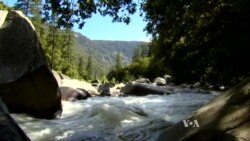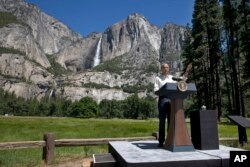Climate change is likely the single most significant threat to the world's natural resources, including America's national parks, according to U.S. President Barack Obama.
Speaking Saturday in Yosemite National Park, Obama said, "One of the things that binds us together is we have only one planet and climate change is probably the biggest threat, not only to natural wonders like this, but to the well being of billions of people, coastal cities, agricultural communities that can be displaced in the span of a few decades by changes in temperatures that mean more drought, more wildfires," Obama said.
With Yosemite's iconic vistas as a backdrop, Obama's remarks were made during an exclusive interview with National Geographic. The full interview will air in late August in commemoration of the 100th anniversary of America's national park system.
On August 25, 1916, President Woodrow Wilson signed into law an act the created the National Park Service (NPS), an agency of the Department of the Interior that manages all national parks in the United States. Wilson formed the NPS to "protect the wild and wonderful landscapes" in the country.
During the interview in the western U.S. state of California, the president urged Americans to help protect the national parks. "This is a solvable problem," he added, by reducing carbon emissions and preserving open spaces.
In addition to climate change, the national parks are also feeling the brunt of a budget shortfall. Interior Secretary Sally Jewell said on Thursday that deferred maintenance totaling a record $12 billion has led to hazardous bridges, crumbling roads and decaying facilities.
Obama last two budget requests included more funding for the parks but congress did not approve them, forcing NPS to seek funding from corporate sponsorships and other alternative sources.
Before visiting Yosemite, located in California's Sierra Nevada mountains, Obama visited two national parks with his family to celebrate the 100th anniversary of the park system.
Obama, his wife and daughters toured a maze of caverns beneath the desert Friday at Carlsbad, New Mexico, before flying to Yosemite.
The Interior Department said Friday that national park visits in 2016 are on pace to beat last year's record of 307 million. It said visitors to the parks last year spent $16.9 billion in local communities surrounding the national parks.
As Obama's presidency ends in January, he appears to be increasingly focused on leaving a favorable environmental legacy. The president added 20 sites or monuments to the national park system since taking office. Half of those were approved by Congress while the other half were created by Obama's use of executive authority.
Some members of Congress have accused Obama of overreaching his authority and argue the government should not acquire more land until it can end a backlog of maintenance projects for current parks.
Environmental groups have urged Obama to do even more to designate more public spaces before he leaves office in January.
The National Park System says it has a "clearly defined process" for screening proposals for new park areas.
Proposals may come from the public, federal, state or local officials. The proposals are then studied by officials with input from the public. Sites eligible for consideration must possess nationally significant natural, cultural or recreational resources; be a feasible addition to the system; and require direct NPS management. If a unit meets the criteria, it can be added to the park service system by and act of Congress.
Here are some other facts about the National Park System:
-
More than 307 million people visited places within the national park system in 2015;
-
The system has grown to include 411 areas since the nation's first national park, Yellowstone, located in the western states of Wyoming and Montana, was created in 1872;
-
The NPS manages more than 84 million acres with 28 different designations, including historical parks, national monuments and preserves;
-
The five most visited national parks in 2015 were the Great Smoky Mountains in North Carolina and Tennessee, the Grand Canyon in Arizona, the Rocky Mountains, which stretches 4800 kilometers from Canada to the western U.S., Yosemite, and Yellowstone;
-
Seven new national parks were designated in 2015. They are the Valles Caldera National Preserve in New Mexico, the First State National Historical Park in Delaware, the Blackstone River Valley National Heritage Corridor in Massachusetts and Rhode Island, the Martin Luther King, Jr. Memorial in Washington, D.C., the Pinnacles National Park in California and the Abraham Lincoln Birthplace National Historical Park in Kentucky;
-
Wrangell-St. Elias National Park, in south central Alaska, is the largest park with 13.2 million acres; and
-
Annual visitor spending within 60 miles of NPS sites support more than 240,000 mostly local jobs and contributes about $27 billion to the U.S. economy.
Every week, VOA Learning English will profile one of the sites within the National Park Service. To learn more, visit










